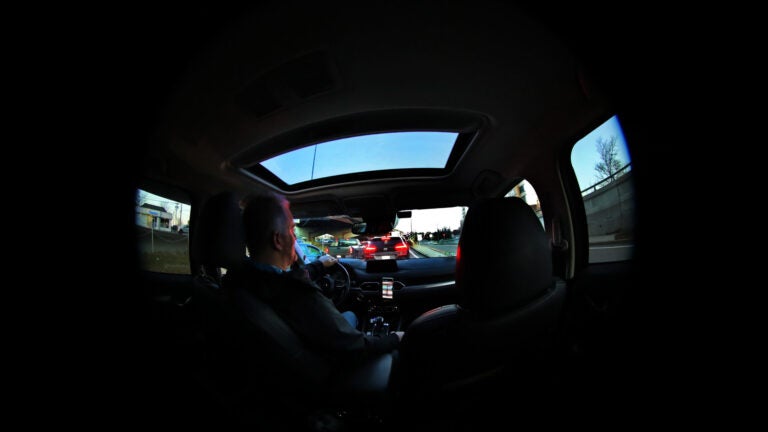What you can — and can’t — do under the new hands-free driving law in Massachusetts
Police will begin enforcing the law Sunday.

Massachusetts recently gained the singular distinction as the only New England state where people are still allowed to hold their phone while driving. That comes to an end Sunday — when the new hands-free driving law takes effect.The long-sought ban on handheld phone use means drivers could be fined at least $100 if they are caught in violation. It also closes a so-called “loophole” in the state’s 2010 distracted driving law that made it virtually “impossible” for police to enforce the ban on texting while driving, according to Rep. Bill Strauss, who co-chairs the state Legislature’s Joint Transportation Committee.However, the law doesn’t mean drivers are completely prohibited from making phone calls, as long as they comply with a number of new rules. Here’s what you can and can’t do, beginning Sunday.OK, so what exactly am I now no longer allowed to do? Massachusetts already bans texting while driving, as well as all handheld phone use by drivers under the age of 18. The new law means that handheld phone use is now banned for adult drivers, unless their device is in hands-free mode. In other words, holding it with one hand while driving — or even cradling it between your ear and shoulder — is no longer allowed.
It’s also worth noting that drivers under the age of 18 are still prohibited from any sort of phone use, even in hands-free mode.
What exactly does hands-free mode mean?
In practice, a number of things.
It could mean a Bluetooth earpiece or speaker. It could mean taking a call through an Apple Watch. It could mean having your device mounted on the dashboard or in a cup holder on speakerphone. It could even mean having someone in the passenger seat holding the phone up to your ear.
The bottom line is that, if you’re making a call, both hands have to be free to operate the car.
So, headphones and earbuds are OK, right?
Actually, no.
Under a separate law, drivers are prohibited from wearing headphones for most purposes, though you are allowed to have in a single earbud for phone calls.
If I’m driving and my phone starts ringing, how am I supposed to answer if I can’t hold or touch my phone?
The law does allow “a single tap or swipe to activate, deactivate or initiate” hands-free mode on your phone. But that’s the limit.
“If they find they’re engaging in several steps with their hands, then they’re really back to handheld use with the phone,” Straus said. “That’s really the bottom line. It’s not just holding it to your ear while you talk.”
Straus also notes that there are ways to set up your phone so that it automatically answers on speakerphone.
Am I allowed to make a call while driving?
If you can do it without touching your phone, sure; using a voice command or virtual assistant like Siri to dial someone’s number is still allowed.
Does that mean I can use voice-to-text messaging?
Yup, as long as you’re abiding by the one-touch rules and can use voice commands to receive or dictate a message.
Is there anytime I can hold my phone while driving in public?
The law does have an exception for emergencies, but that doesn’t give drivers a carte blanche excuse.
Say if your car breaks down on the road, the other passenger in your car is having a heart attack, or you pass something like an accident or a house on fire — anything that requires a response from public safety officials — then handheld phone use is allowed.
Straus stresses that it’s not an all purpose excuse; drivers would have to show they’re responding to a legitimate emergency. And while you’d still technically be in violation, the law says such evidence is an “affirmative defense.”
The law also exempts on-duty public safety personnel and first responders.
If I really need to hold my phone to use it for a non-emergency reason, what can I do?
You could pull off onto a breakdown lane — or onto the shoulder of the road, as long as you’re not blocking traffic.
What if I’m stopped at a stop sign or traffic light? Then can I pick up my phone to make a quick call?
Nope. No matter how long the light is, you’re technically still in a travel lane.
“Eventually you’re going to be expected to be traveling again,” Straus said, noting that it creates the potential for a hazard.
What about if I’m stopped at a train crossing?
Still, no.
What if it’s a drawbridge and the boat is taking forever to pass through, and seriously it’s just a 10-second call?
No!
What about in a parking lot?
Sure, as long as you’re not moving or in the way of possible traffic. Even private parking lots are technically considered public ways. So making a call in a parking space is still OK — but not while you’re driving around looking for a spot.
How about in my own driveway? Then can I pick up my phone while moving?
Go for it. Driveways aren’t legally public ways, though that doesn’t necessarily mean it would be a good idea.
Can I still look at my phone for things like Google Maps and Waze?
Yes — as long as you set it up before you start driving.
While the law otherwise bans drivers from looking at any “text, images or video displayed on a mobile electronic device,” it does have an exception for navigation apps, like Google Maps and Waze. The rules also say that your phone has to be mounted or affixed to the car windshield, dashboard, or center console “in a manner that does not impede the operation of the motor vehicle,” if you’re using it for a navigation app.
Does that mean I can enter or change directions on the app while driving?
No, once you begin driving, navigation apps are only allowed to be used in hands-free mode. Straus notes that both Google Maps and Waze have voice-command functions.
What about Spotify? Can I switch songs while driving?
Nope.
Besides the aforementioned exceptions, any other physical use of your phone while driving is not allowed. If you’re trying to set up a playlist or podcast, do it before you get going; once you’re on the road, it’s illegal to touch your phone to even switch songs. And while some apps like Spotify do have a mobile hands-free function, you’re technically not allowed to look at your phone for anything other than navigation purposes. .
Simply put, as Straus says, “if it’s on your telephone, it’s now banned.”
What if I can operate the app through my car dashboard?
This gets into what Straus calls a bit of a “gray zone.”
It remains legal to operate apps on your car’s console, whether they’re built into the dashboard, such as Apple CarPlay and Android Auto, or used through an auxiliary connection. That doesn’t mean it’s necessarily safe.
Straus notes that there are catch-all charges for negligent driving, which can include all sorts of distractions. And as car technology continues to increase, he expects that in-dash apps will be something future legislation will need to address at the factory level.
“The fractions of seconds — and they’re significant — that car dashboards draw on operators’ attention are a growing problem,” he said.
How will the ban on handheld phone use be enforced?
This is another significant difference. The new hands-free law will be enforced as a primary offense, which will make it easier for police to crack down on texting while driving, in addition to other phone uses. Previously, the texting ban was difficult to substantiate and likely to be overturned upon appeal, according to Straus, since drivers could say they were just dialing someone’s number to make a call.
“From a law enforcement perspective, it was almost impossible to enforce,” Straus said. “From the distance they are, they can’t tell.”
But now, if a police officer passes a driver holding a phone, that in itself is evidence for a citation.
How much do citations cost?
Your first citation will set you back $100, and it only escalates from there. Second offenses call for a $250 fine and that doubles to $500 for third fines and anything after that. Also, the new law requires drivers to complete a course on distracted driving after their second offense.
Does this apply to bicyclists?
No.
Despite some initial confusion (as well as the arguably more dangerous nature of using a phone while cycling), the new hands-free law only applies to motor vehicles. That also means that things like electronic scooters, should they ever come to Boston, are also excluded for now.
Will officers start handing out tickets Sunday?
Not yet. While the law takes effect Sunday, police will only issue warnings for first violations until the end of March.
“Police will be in a public education mode as this rolls out,” Straus said.
What’s next?
Straus says the new law is a major — and long overdue — improvement to the state’s distracted driving laws. But that doesn’t mean it’s the end of the road.
Researchers have found that hands-free technology, while safer than the alternative, is still mentally distracting, and Straus thinks the increasingly prevalent issue of apps that are pre-installed in car dashboards will need to be somehow addressed.
“I don’t think states are done with having to deal with the issue of distracted driving, just because we’ve made this significant improvement,” he said.






Conversation
This discussion has ended. Please join elsewhere on Boston.com